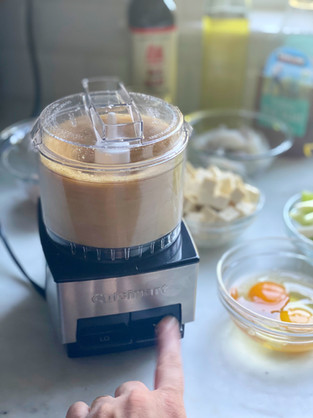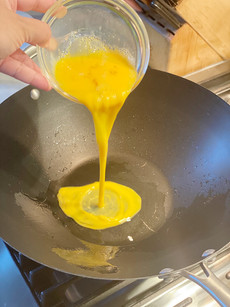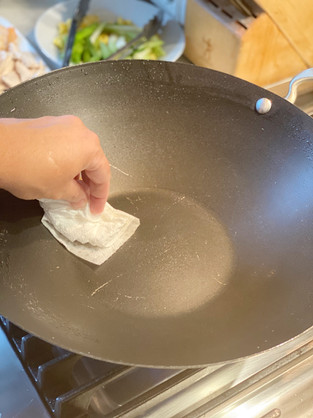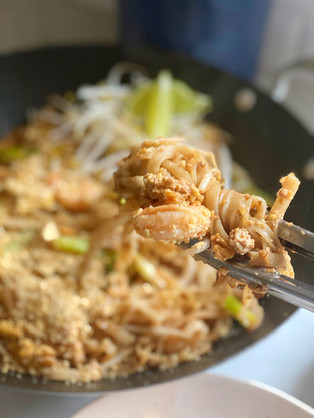Better than takeout...and it lands on your table in less time, too.

Really good takeout pad thai is hard to come by, in my opinion. Just like pizza, the so-so variety is available anywhere, but great pad thai is hard to find. This recipe is a close second to the very best pad thai I have ever had, and better than the overwhelming majority I have sampled in a lifetime of living in New York and "ordering in." Chewy but not mushy, peanut flavor-packed but not saucy, is the name of the game. Fish sauce is an absolute must and soy sauce is to be eschewed. The classic method to make pad thai is to build it in the wok, ingredient by ingredient. The rice noodles are best soaked, not boiled. Copious fish sauce and tamarind impart authentic flavor. Make this just once and it will become a staple in your recipe rotation.
Equipment: cutting board; chef’s knife; dry and wet measuring cups; measuring spoons; mini food processor (optional); small mixing bowls; whisk; wok or large nonstick sauté pan; wooden spoon; tongs

Ingredients:
1 pound pad thai rice noodles
1/3 cup tamarind paste
1/3 cup water
¼ cup fish sauce
¼ cup agave
4 tablespoons vegetable oil, divided
2 eggs, beaten
2 bunches scallions, white and light green parts cut into 1-inch pieces
12-16 large shrimp, peeled and deveined
1 chicken breast, thinly sliced
1-2 cups fresh bean sprouts
½ cup diced extra firm tofu
½ cup finely chopped peanuts, divided
cilantro leaves and lime wedges for garnish
1. First, soak the noodles. Place the noodles in a large bowl filled with boiling water or very hot water from the sink. Soak for 10 minutes, until the noodles are tender but "al dente."
Drain and set aside.
ILOC tip: do not oversoak the noodles or you'll end up with mushy pad thai. Properly soaked noodles are able to absorb the sauce when added in the wok, continuing to cook and becoming one with the flavors.
2. While the noodles are soaking, combine the tamarind, water, fish sauce, and agave in a bowl. Blend well to combine and set aside.
3. Heat a large wok or large nonstick sauté pan over medium-high heat. Once hot, add 1 tablespoon of oil and swirl to coat the pan. Add the eggs and swirl in the pan, continuing to shake the pan as the eggs cook. Break up the eggs with a wooden spoon or paddle and remove from the wok. Set aside.
4. Return the wok to the heat and add another tablespoon of oil, swirling to coat the pan. Add the scallions and sauté for 1-2 minutes. Remove from the wok and set aside.
5. Return the wok to the heat and add another tablespoon of oil, swirling to coat the pan. Add the shrimp and sauté for 1-2 minutes, until just pink. Do not overcook. Remove from the wok and set aside. Wipe the wok clean with a paper towel.
6. Return the wok to the heat and add the final tablespoon of oil, swirling to coat the pan. Add the sliced chicken and sauté for 1-2 minutes, until no longer pink. Remove from the wok and set aside.
ILOC tip: freeze the chicken breast for one hour prior to slicing it. The chicken breast will become partially frozen, which will make it much easier to make evenly thin slices to cook in a minute or two in the wok.
7. Add the drained rice noodles to the pan. Pour in the tamarind-fish sauce mixture and immediately toss well to coat and evenly distribute the sauce. Return the egg, scallion, shrimp, and chicken to the pan, along with the bean sprouts and tofu, tossing well to incorporate. Toss in half the chopped peanuts and sook the pad thai until the sauce is almost entirely absorbed.
8. Serve the pad Thai with the remaining peanuts sprinkled on top, along with cilantro leaves and lime wedges.
Makes 4-6 servings.





































































Comments